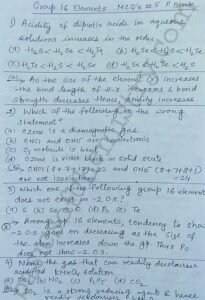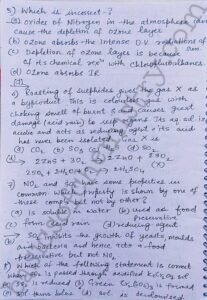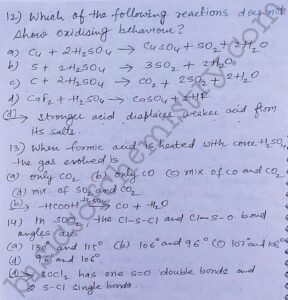MCQ’s group 16 elements p block elements Class 12
Introduction
Group 16 Elements are also known as P-Block Elements and are located on the right side of the periodic table. This group consists of six elements Oxygen (O), Sulphur (S), Selenium (Se), Tellurium (Te), Polonium (Po) and Livermorium (Lv). Elements of group 16 are essential for life and have a wide range of industrial applications. In this article, we will discuss the chemical and physical properties, occurrence and applications, FAQs, and MCQs related to these elements.
Description
What are Group 16 elements?
Group 16 elements have six valence electrons and belong to the p-block of the periodic table. They are non-metals or metalloids. Generally, they have high electronegativity and reactivity, making them essential for various biological and chemical processes.
Electronic configuration of group 16 elements p block elements
General electronic configuration of Group 16 elements is ns2 np4. This configuration allows them to have six valence electrons.
Examples of group 16 elements like Oxygen is a colourless, odourless gas that is essential for life. Sulphur is a yellow solid that is used in the production of sulphuric acid and matches. the element like Selenium is a grey crystalline solid that is used in glassmaking and electronics. Tellurium is a grey metalloid that is used in alloys and semiconductors. Polonium is a rare radioactive metal that is used in nuclear batteries and cancer treatments. Livermorium is a synthetic radioactive element that was discovered in 2000.
Properties and Applications of group 16 elements p block elements
Chemical and physical properties of group 16 elements p block elements
Group 16 elements have unique chemical and physical properties. They have high electronegativity and reactivity and tend to form covalent bonds. Group 16 elements have various oxidation states with -2 being the most common. They exist in various forms such as solids, liquids, and gases at room temperature.
Occurrence and applications
Group 16 elements occur naturally in the earth’s crust and are found in minerals and ores. Group 16 elements are also important for biological processes such as DNA and protein synthesis. They are used in various industrial processes such as in the production of sulphuric acid, vulcanisation of rubber and glassmaking.
Uses in industry of group 16 elements p block elements
Sulphur is used in the production of sulphuric acid which is used in fertilisers, detergents, and other industrial processes. Element Selenium is used in glassmaking and electronics as well as in dietary supplements. Tellurium is used in alloys, semiconductors and solar cells.
Importance in biological and chemical processes in p block elements
Group 16 elements are essential for various biological and chemical processes. Oxygen is necessary for respiration and energy production. Sulphur is important for protein synthesis. Elements like Selenium and tellurium are important for enzyme activity and DNA synthesis.
MCQs related to the properties of group 16 elements P block elements
- Which of the following group 16 elements is a liquid at room temperature? a) Oxygen b) Sulphur c) Selenium d) Polonium
Answer: b) Sulphur.
Element Sulphur is a nonmetal that is typically a yellow solid at room temperature. But can also exist as a red or brown liquid under certain conditions.
- Which group 16 element is commonly used as a semiconductor in electronic devices? a) Oxygen b) Sulfur c) Selenium d) Tellurium
Answer: d) Tellurium.
Element Tellurium is a metalloid that is commonly used as a semiconductor in electronic devices such as solar cells, infrared detectors and thermoelectric devices.
- Which of the following group 16 elements is a key component of proteins? a) Oxygen b) Sulfur c) Selenium d) Tellurium
Answer: b) Sulphur
Element Sulphur is an important element in biological systems where it is a key component of proteins and plays a role in many metabolic processes.
- Which group 16 element has the highest electronegativity? a) Oxygen b) Sulphur c) Selenium d) Polonium
Answer: a) Oxygen.
Element Oxygen has the highest electronegativity of the group 16 elements, meaning it has a strong tendency to attract electrons towards itself in a chemical bond.
- Which group 16 element is commonly used as a fumigant and disinfectant? a) Oxygen b) Sulphur c) Selenium d) Tellurium
Answer: b) Sulphur
Element Sulphur is commonly used as a fumigant and disinfectant in agriculture and medicine due to its antimicrobial and insecticidal properties.
FAQs group 16 elements of p-block elements
Q What are group 16 elements?
A Group 16 elements are also known as chalcogens, are a group of p-block elements in the periodic table that include oxygen, sulphur, selenium, tellurium, and polonium. They have six valence electrons and exhibit a range of physical and chemical properties.
Q What are the properties of group 16 elements?
A Group 16 elements are known for their ability to form oxides, exhibit allotropy and have a range of melting and boiling points. They are also known for their reactivity and ability to bond with other elements to form compounds.
Q What are the uses of group 16 elements?
A Group 16 elements are used in a variety of industrial and scientific applications. For example sulphur is commonly used in the production of fertilisers. Selenium is used in the production of photovoltaic cells. Polonium is primarily used in scientific research due to its radioactive properties.
Q What is allotropy?
A The phenomenon where an element can exist in different forms with different physical and chemical properties is known as allotropy. Sulphur is a well-known example of an element that exhibits allotropy with several different allotropes including rhombic, monoclinic and plastic sulphur.
Q What is the most common use of sulphur?
A Commonly Sulphur is used in the production of fertiliser but also has other important uses. It is used as a reducing agent, in the vulcanisation of rubber and in the production of sulphuric acid.
Q What is the role of oxygen in respiration?
A Oxygen plays a critical role in the process of respiration, where it is used by cells to generate energy through the process of cellular respiration. In this process, oxygen is used to break down glucose molecules and release energy in the form of ATP.
Q What is the main use of selenium?
A As we know, Selenium is an important element in the field of electronics and is used in the production of photovoltaic cells, which is used to generate the solar power. It is also used in the production of semiconductors and in the production of glass.
Q What is the radioactive element in group 16?
A Polonium is the only radioactive element in group 16 of the periodic table. It is a highly toxic element and is primarily used in scientific research, particularly in the field of nuclear physics.
FAQs group 16 elements p block elements
What is the most common oxidation state of Group 16 elements?
The most common oxidation state of Group 16 elements is -2.
What is the electronic configuration of tellurium?
The electronic configuration of tellurium is [Kr] 4d10 5s2 5p4.
What is the formula for hydrogen sulphide?
The formula for hydrogen sulphide is H2S.
What is a common use of Group 16 elements?
Group 16 elements are commonly used in various industrial processes, such as the production of sulphuric acid and vulcanisation of rubber.
Conclusion
Group 16 elements are essential for life. They have a wide range of industrial applications after understanding their unique properties.
For explanation of the notes go through the video 👇
Important MCQs #5 Group 16 Elements P Block Elements Class 12
For more updates join me on 👇
You Tube Channel https://www.youtube.com/c/ChemistrywithMonamam
Website – https://basicsofchemistry.com/
Instagram – https://www.instagram.com/monabindalgupta/
Facebook – https://www.facebook.com/monabindalgupta/
Twitter – https://twitter.com/monabindalgupta
Quora – https://www.quora.com/profile/Mona-Gupta-202
LinkedIn – https://www.linkedin.com/in/mona-gupta-7b450519a




